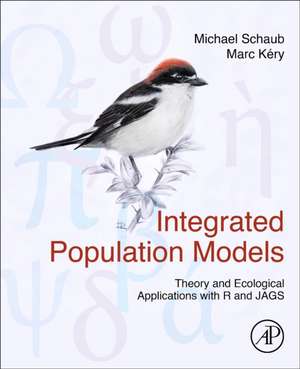Integrated Population Models: Theory and Ecological Applications with R and JAGS
Autor Michael Schaub, Marc Kéryen Limba Engleză Hardback – 16 noi 2021
Written by two population ecologists with expertise on integrated population modeling, this book provides a comprehensive synthesis of the relevant theory of integrated population models with an extensive overview of practical applications, using Bayesian methods by means of case studies. The book contains fully-documented, complete code for fitting all models in the free software, R and JAGS. It also includes all required code for pre- and post-model-fitting analysis.
Integrated Population Models is an invaluable reference for researchers and practitioners involved in population analysis, and for graduate-level students in ecology, conservation biology, wildlife management, and related fields. The text is ideal for self-study and advanced graduate-level courses.
- Offers practical and accessible ecological applications of IPMs (integrated population models)
- Provides full documentation of analyzed code in the Bayesian framework
- Written and structured for an easy approach to the subject, especially for non-statisticians
Preț: 601.36 lei
Preț vechi: 767.27 lei
-22% Nou
Puncte Express: 902
Preț estimativ în valută:
115.07€ • 125.39$ • 96.96£
115.07€ • 125.39$ • 96.96£
Carte tipărită la comandă
Livrare economică 16-30 aprilie
Livrare express 18-22 martie pentru 112.32 lei
Preluare comenzi: 021 569.72.76
Specificații
ISBN-13: 9780323908108
ISBN-10: 0323908101
Pagini: 638
Ilustrații: 225 illustrations (25 in full color)
Dimensiuni: 216 x 276 x 40 mm
Greutate: 1.95 kg
Editura: ELSEVIER SCIENCE
ISBN-10: 0323908101
Pagini: 638
Ilustrații: 225 illustrations (25 in full color)
Dimensiuni: 216 x 276 x 40 mm
Greutate: 1.95 kg
Editura: ELSEVIER SCIENCE
Public țintă
Integrated Population Models is an invaluable reference for researchers and practitioners involved in population analysis, and for graduate-level students in ecology, conservation biology, wildlife management, and related fields. The text is ideal for self-study and advanced graduate-level courses.Cuprins
1. Introduction
Part I: Theory of Integrated Population Models2. Basics of Bayesian Modeling3. Introduction to Stage-Structured Population Models4. Components of Integrated Population Models5. Introduction to Integrated Population Models6. Benefits of Integrated Population Modeling7. Assessment of Integrated Population Models8. Integrated Population Models with Density-Dependence9. Retrospective Population Analyses10. Population Viability Analyses
Part II: Integrated Population Models in Practice11. Woodchat Shrike12. Peregrine Falcon13. Greater Horseshoe Bat14. Hoopoe15. Black Grouse16. Barn Swallow17. Elk18. Cormorant19. Grey Catbird20. Kestral21. Black Bear22. Conclusions
Part I: Theory of Integrated Population Models2. Basics of Bayesian Modeling3. Introduction to Stage-Structured Population Models4. Components of Integrated Population Models5. Introduction to Integrated Population Models6. Benefits of Integrated Population Modeling7. Assessment of Integrated Population Models8. Integrated Population Models with Density-Dependence9. Retrospective Population Analyses10. Population Viability Analyses
Part II: Integrated Population Models in Practice11. Woodchat Shrike12. Peregrine Falcon13. Greater Horseshoe Bat14. Hoopoe15. Black Grouse16. Barn Swallow17. Elk18. Cormorant19. Grey Catbird20. Kestral21. Black Bear22. Conclusions
Recenzii
"This book represents the fourth in a series involving one or both of these authors. Their volumes all provide the theory underpinning the models, a heuristic description of the models, and R code for implementing them. Their books and accompanying workshops are fueling a rapid shift in the approach to analyses of ecological data. This newest work will move population ecology fully into the Bayesian paradigm. Every important advance in methodology is, however, a double-edged sword; with the increased analytical power comes an increase in the number and magnitude of potential errors. Integrated population models are no exception. Schaub and Kéry address many of these potential problems but they could have been a bit stronger in emphasizing the importance of such problems. Despite this minor criticism, this is an important volume that will revolutionize the practice of population ecology. Every population ecologist should own a copy." --The Quarterly Review of Biology
